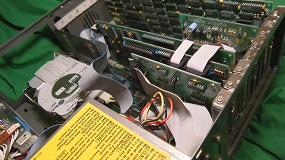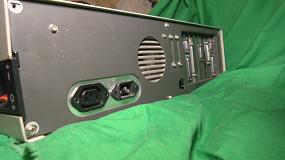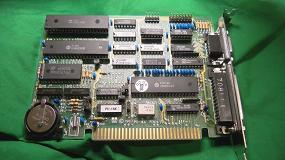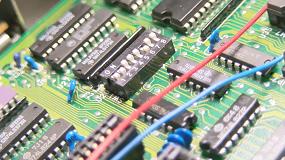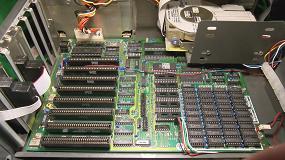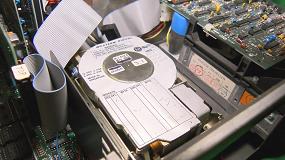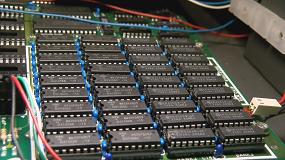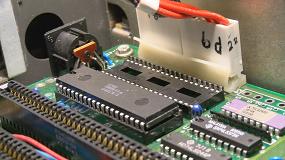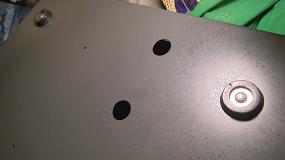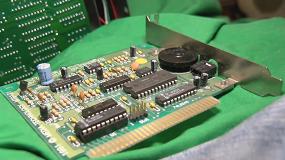|

Overview

Sophia powers on without incident
Spurred on by the reasonable
success of the IBM 5150, IBM released its successor in 1983, the 5160,
later dubbed the 'XT'. This was mostly an incremental upgrade, using the
same 4.77MHz 8088 and offering little beyond an additional three expansion
slots - the 5150 had only five, where the 5160 had eight, though the
eighth slot is 'special' - not really, but it is wired slightly
differently. Slot 8 is essentially considered an external bus and cards
using it must be able to generate a select signal. Not all cards can,
though some have compatibility switches for it. In any case, the system
was otherwise quite successful, even if a little disappointing, which
didn't go unnoticed.
Naturally, like any other
successful system, it wasn't long before people figured out how to copy
it. In principal this is quite easy, because the PC used off-the-shelf
chips with no exclusivity contract, meaning that anyone could buy those
parts and assemble a PC. Indeed, the CPU itself was already being cloned,
albeit under license, as IBM had (sensibly) insisted on having 'second
sources' in case the product sold well and Intel couldn't fulfil the
quantity of an order. Otherwise the system was largely glue logic,
available from countless manufacturers. The real obstacle was the BIOS, as
IBM themselves owned the rights to this and didn't really like the idea of
other companies using it. This didn't stop clone makers, who in some cases
did just steal and modify the IBM BIOS, but before long it was
reverse-engineered and third party versions became available. Companies
such as AMI and Award would offer their own BIOS, which a motherboard
manufacturer could then buy a license for and implement it in their PC
Compatible, all without having to worry about legal issues and the wrath
of IBM. It goes without saying that the results varied greatly from one
BIOS to another and across different hardware. Some systems were more
compatible than others.
With the 5160 successfully
cloned, it really didn't take long at all until people looked to improve
upon the design. For one thing, the 8088 was available in versions
specified to run at higher clocks than the meagre 4.77MHz version. Also
the IBM motherboards required minor alterations to take the full 640K of
RAM which was a problem easily eliminated. Mostly leveraging cheaper Asian
manufacturing and, certainly, lower quality control measures, clone
systems rapidly began appearing which ran at 8MHz or higher, could be
expanded up to 640K of DRAM right out of the box and even had power
supplies better suited to hard drive installations - a costly option that
wasn't widely adopted at first. These machines would garner the moniker
'Turbo XT', thanks to a button marked 'Tubro', which allowed the user to
select between the higher clock speed for performance and the original
4.77MHz for compatibility.
At their lower price point,
the Turbo XT machines proved quite popular and even helped getting PCs
into the home. The PC platform still had a very long way to mature, but
the building blocks were now there and the Compatible market would rapidly
expand, their compatibility and features would improve and, eventually,
surpass IBM in sales and capabilities. Indeed, IBM only really held their
technological lead for one more generation, the 286, which was again
rapidly outperformed by Compatible systems, which then went on to beat IBM
to using the later 386. Love it or hate it, this was generally good for
everyone, except perhaps IBM, who had created a market only to
increasingly have the carpet ripped out from under them as time went on.
Our system here is a rather
late one, being manufactured in 1988, though examples exist from the
1990s. Despite being barely a year away from the 486's eventual release -
the 386 being three years old already - despite VGA being a year old and
despite the 286 looking reasonably priced by this year, the Turbo XT
remained a popular choice for its low price. It usually came equipped with
a monochrome video card
 - normally at least Hercules compatible
- normally at least Hercules compatible
 - or at best
a CGA card. Some systems still came with less than 640K of RAM. Rarely the
user would pay the extra money for a tiny hard drive. Hey, most software
was still written to work from floppies on the 8088 at this time, because
of the sheer numbers of such systems, and would remain this way into the
early 1990s. It was no speed demon, but the Turbo XT was still a perfectly
capable machine for the next few years. Such a machine would have been
many people's first experience with a PC. Perhaps it wasn't the best one,
but it was good enough and it mostly got the job done.
- or at best
a CGA card. Some systems still came with less than 640K of RAM. Rarely the
user would pay the extra money for a tiny hard drive. Hey, most software
was still written to work from floppies on the 8088 at this time, because
of the sheer numbers of such systems, and would remain this way into the
early 1990s. It was no speed demon, but the Turbo XT was still a perfectly
capable machine for the next few years. Such a machine would have been
many people's first experience with a PC. Perhaps it wasn't the best one,
but it was good enough and it mostly got the job done.
Beware, if you plan to pick
up an XT machine: Whilst using the same DIN5 connector, the keyboard
interface is slightly different and you will need a compatible keyboard.
 |


